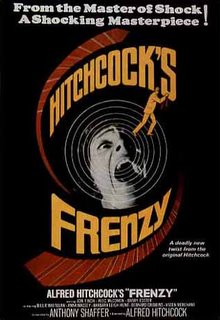
"Lovely, lovely, lovely, lovely!"
Frenzy disproves the notion that director Alfred Hitchcock wanted to abstain from showing graphic-imagery, in-favor of cut-aways and the implied. This idea is not true. Frenzy is one of the master's most underrated-films, and his only "R-rated" motion-picture. But is it good? It is incredible. For those who would argue that "Hitchcock didn't show everything because he didn't want to" are proved-wrong by this film and by 'Psycho' (where in 1960, he pushed-the-envelope, changing movies forever). There is a simple reason for why Alfred Hitchcock didn't "show everything" in his earlier depictions of violence and murder: he wasn't allowed-to by standards-and-practices. The reality is, the master of the suspense-thriller had to use his own production-company to create Psycho at-all. By 1972, the changes wrought by Psycho and the imitators were being-felt (as well as major cultural-changes throughout the West), and he could get-away with showing some pretty graphic-violence. Does he? Oh yeah, you bet. There isn't much blood, but you see some pretty horrific-depictions of murder that the camera dwells-on for a long-long time. He showed as much as he could in all of his films, and said so for decades, and a film like Frenzy can be seen as his response to auteurs like Dario Argento. His usual sexual-subtext is out-in-the-open, and gloriously so, and so is the violence.
Ostensibly, this was to be Hitchcock's triumphant return to the UK, and it put him squarely back-at-the-top again. London in the early-1970s still looked Victorian, there were still scars from the Blitz, and it held an interesting-charm that this film captures so well. Frenzy is very-much like the film of a young man, and yet Hitch was in his 70s! The fact is, he was willing to take-chances and experimented with sound and image-techniques. He was often well-ahead of his time. There is a great cinematic moment in the story where "Babs" the barmaid is walking-out of a flat, when the entire soundtrack goes-silent--the necktie-murderer, Bob Rusk ("Bob's your uncle!"), suddenly appearing- from-behind her smirking. It is riveting and startling. Why? Because in classic Hitchcockian-fashion, he has already told us that Rusk is the serial-killer. Yes, this is possibly one of the very-first films to clearly illustrate this kind of killer, even before Uli Lommel's "Tenderness of Wolves" (1973). In 1972, the concept of the "serial-killer" was very new, and almost unknown. Fritz Lang's "M" (1931) has the distinction of being first.
The "wrong man" in this story was originally called "Blamey" (or, "blame ME'!), but Hitch wisely changed it, it would have been too-obvious. BUT, he does play the audience, sending mixed-messages about Mr. Blaney's possible guilt, until a key-scene that comes very-early in the film with Mr. Rusk. You won't miss-it, and it includes the most nudity in any Hitchcock film we will ever see (a first for Hitch). Hey, Hitchcock rarely did "mysteries", he did thrillers. In a suspense-thriller, you show-everything to the audience that you can. There are so many aspects of technique in this film that work, and the cinematography is really solid and eye-catching. Hitch had a great eye for composition too, and it often surprises viewers that he rarely ever looked-through the lens--ever.
Again, this is familiar-territory for Hitchcock-fans. The premise of the "wrongly-accused" protagonist is a running-theme in his films, and a very personal one. You see, Hitch disliked and feared the Police, and was fearful of their incompetence in apprehending the guilty. It is said that he avoided the presence of Policemen, and became extremely-nervous when they were around him in public. This is what makes a great suspense/thriller/horror director--a man with many-many fears and complexes! As-usual, we also get the patented gallows-humor, best-expressed by the poor Police Chief's meals at-the-hands of his wife! A real hoot. It's safe-to-say that Alfred Hitchcock invented the suspense-thriller, and innovated horror into the modern-age in movies.
There were others like George Romero with his "Night of the Living Dead" in 1968, and even the teleplays and screenplays of Richard Matheson (or the writings of Harlan Ellison, Robert Bloch & H.P Lovecraft), but it was Hitchcock who made it all possible in mainstream-movies. We could use another director like him, but they only come-along so often. They have to be cultivated, and this isn't happening in this period of film history very often. With-luck, Hollywood will stop making films and simply distribute them again. If the career of Alfred Hitchcock illustrates anything, it is that you have to allow the artist to get on with what they do best. "Frenzy" was a hit, after-all, and literally suffered ONE cut, a close-up of a victim's tongue sticking out of her mouth! You couldn't make this film today, not with the topless strangling-scene.
No comments:
Post a Comment